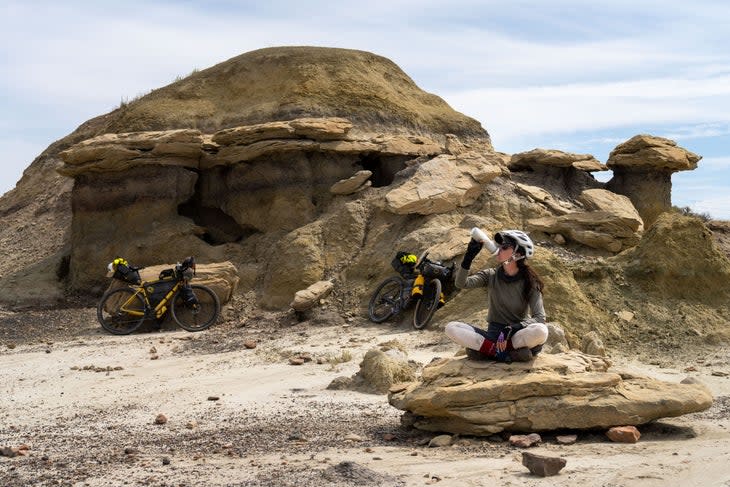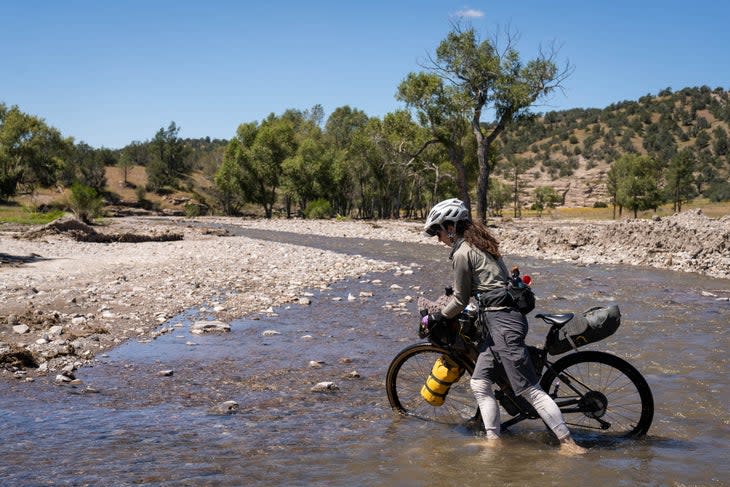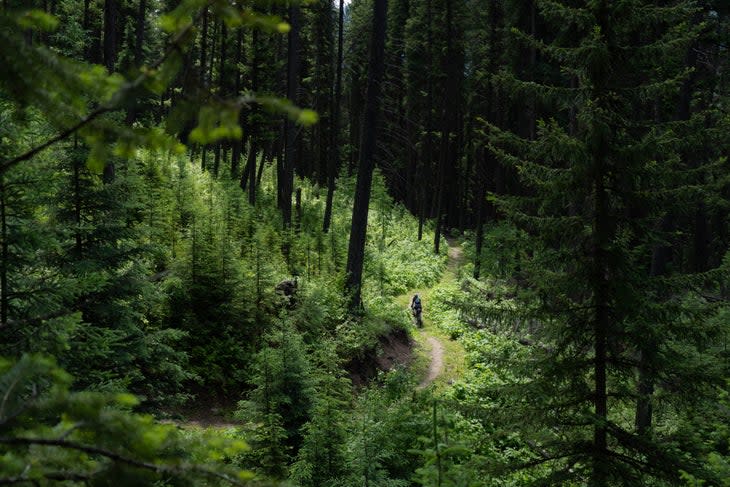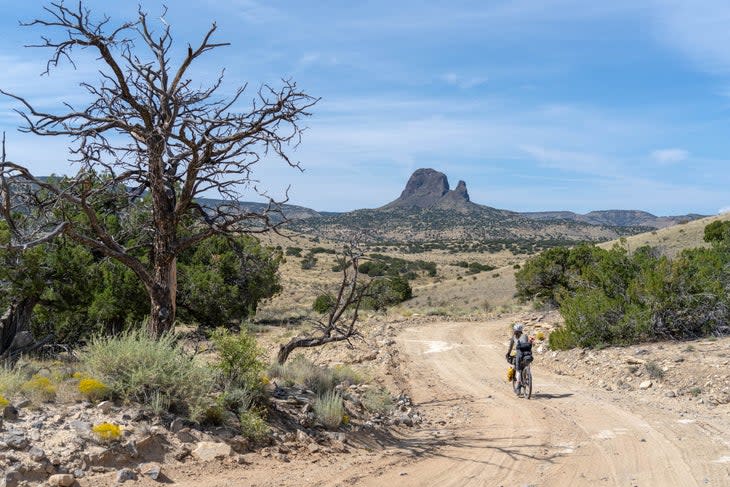What Bikepacking 2,700 Miles Taught My Partner About Limits and Living with Long COVID
- Oops!Something went wrong.Please try again later.
This article originally appeared on Outside
"Fucking alarm!" Chelsea yelled. I heard the heart rate monitor go off and turned around to see my wife bent over her bike's handlebars for what felt like the thousandth time. Halfway up a mountainous dirt trail, she dismounted and decided to walk rather than ride again. We were 80 miles into the longest bikepacking trip we'd ever attempted, and we still had more than 2,600 miles left to go.
In October 2020, my wife, Chelsea, and I caught COVID-19. We were lucky: by the end of the week we were upright and functioning humans again. We were able to continue working from home and going about our lives in quarantine. But in week two, complications surfaced for Chelsea that she is still dealing with today.
Chelsea is part of the more than 20 percent of COVID patients called "long-haulers," sufferers who experience a range of symptoms including chest pain, difficulty breathing, neurological issues, and a myriad of other complex ailments. She developed severe heart pain that initially kept her bed-bound, and over a six-month period gradually lessened to allow her to walk without pain. But whenever she exerted herself too much, she was right back where she started.

Now in 2023, we are just beginning to appreciate the scale and severity of long COVID. Experts estimate that it currently affects 16 million Americans alone. The virus spared many athletes and active people from death or hospitalization, but some of them remain unable to attain their pre-disease fitness. The majority of long COVID patients are in their thirties to fifties.
My wife and I aren't professional athletes by any stretch, but trail running and our time outdoors have always been core to our happiness and a big part of how we define ourselves. For a woman who used to run up mountains, long COVID is a life-altering illness.
"It was the unknown that was terrifying for me," Chelsea told me recently. "There were no warning signs that I had pushed my heart too hard until the next day when I would wake up with chest pain. Did I walk too fast for that bus? Did I carry the groceries too far? Wearing a heart rate monitor was the only way I could keep myself from triggering the pain. It's frustrating to feel like you can do more but get punished for it later. "
It's one of the longest endurance gravel bike routes in the world with nearly 150,000 feet of elevation gain. Sitting in her PJs, still barely able to walk up a flight of stairs, she decided this was a rational goal.
Like many long-haulers, Chelsea struggled to get a clear diagnosis from physicians. A year of neurologist, cardiologist, and hospital visits provided no answers other than a vague suggestion of post-exertional malaise. She was left grasping for a solution to get outside and stay active in a way that her body could tolerate. Mostly she was searching for hope--an adventure and a goal that would prove some normalcy was possible in the face of an ill-defined disease with no cure in sight.
Somewhere in the gloom of 2021, Chelsea stumbled across a webpage for the Great Divide Mountain Bike Route, a 2,700-mile, mostly unpaved ride from the Canadian Rockies through the mountains of the U.S. to the Mexican border. It's one of the longest endurance gravel bike routes in the world with nearly 150,000 feet of elevation gain. Sitting in her PJs, still barely able to walk up a flight of stairs, she decided this was a rational goal.
We spent 2021 slowly increasing our training, finding the precise heartbeats per minute (135 BPM) that would allow her to push her body but not send her back to bed-bound recovery. It was an agonizingly slow process. First, we tried little things like walking home from the grocery store, then doing so while carrying bags. We'd add in small five- to ten-mile bike rides, only to overdo training and send her right back to square one. But finally, in July of 2022, after several successful, slow 200-300 mile practice trips with fully loaded bikes, we packed our bags and set off on this wild journey.
The route starts in Banff, Alberta, and the first day brings riders past Kananaskis Country and the beautiful Mount Engadine Lodge, which is the place where Chelsea and I were married. We began the ride on our five-year anniversary, and planned to meet her parents at the lodge for a late afternoon lunch to celebrate.

Chelsea started struggling less than an hour after we set off. She couldn't keep pace like we had on previous training rides. Then the heart pain started. Stuck under the imposing views of Mount Rundle between Banff and the lodge, unable to pedal more than 15 minutes without stopping, we realized we weren't going to reach the lodge. We hobbled our way off the route and back to gravel roads hours behind schedule. We didn't call Chelsea's father, but his truck appeared in the distance. He parked, got out, and hugged her without saying a word, sensing the pain and fear and disappointment that she had been going through all day.
As we settled down in camp that night, we took a serious look at our contingency plans and discussed scrapping the entire adventure for safety's sake.
Chelsea was terrified she'd misjudged the whole trip. "I was worried about making it to the American border, let alone the Mexican one,” she said. "Giving up on day one felt like surrendering to the idea that I would never get better."
I thought we should cancel. We had emergency provisions and GPS trackers, but what if she became bed-bound in a tent? On the other hand, what if we canceled and her morale was crushed?
We decided that not trying was worse than risking failure.

The next morning was a somber one as we packed up and headed out into an unknown future. As we left camp and started walking our bikes up Elk Pass into British Columbia, we met two cyclists at the top of the climb. They'd heard there was a mother grizzly with two cubs on the route, and we decided safety was better in numbers. With our merry band assembled, we careened down the trail singing and shouting at the top of our lungs like school children on sugar. It was rejuvenating to see Chelsea happy and alive in the mountains in a way that two years of COVID had stolen. Her spark was back.
Days trickled by and we made progress. We eventually made it to Montana, 430 miles down the trail, stumbling into Holland Lake after a 95-degree day in the sun. As we emerged vaguely cleaner, we met a pair of cyclists we'd spend the next few weeks hopscotching with on our way south. Drying around the fire that night, we learned that they were also battling the aftermath of COVID.
Gitty, from the Netherlands, was another long-hauler. She contracted COVID in April 2021, but instead of heart issues, she'd been suffering from shortness of breath, lung complications, and persistent tinnitus.
"I was full of energy and looking forward to riding the GDMBR, but that changed after I got long COVID," Gitty explained. "It took me a long time to get my fitness back and I was afraid I couldn't keep up, especially at the high altitudes along the route. It caused me a lot of stress. And while we took it easy and didn't get as far as we planned, cycling the GDMBR after COVID has made me more positive about the future."
Gitty was cycling with her husband, Jan Jaap, a brawny guy who muscled his bike down the trail like a viking steering a ship. We rode with them for several days as he led our group up gravel ascents and down mountain passes. Jan and I often got carried away and sped ahead of our partners, only to sheepishly remember that we were there for support and bring our pace back down.
It was rejuvenating to see Chelsea happy and alive in the mountains in a way that two years of COVID had stolen. Her spark was back.
It was hard to dial back the pace at times. I'd get frustrated and remind myself that my partner was having a hard time. Then, I'd feel a rush of guilt for losing my patience. Chelsea felt it more acutely: like she was being held back by something she couldn't control.
"In the beginning of the ride I worried constantly about slowing us down," she said. "But I realized even if I had to walk up every hill, or if we only made it halfway, it was being back on the bike and with my partner that really mattered."
We met cyclists overcoming obstacles of all kinds: rheumatoid arthritis, diabetes, persistent injuries, among other ailments. They persevered because they loved nature and pushing themselves in the outdoors regardless of physical restrictions.
Near the southern end of Wyoming, 1,400 miles in, we found our balance. Chelsea, while still limited, hit a groove we could comfortably ride at all day. I'd follow behind and belt Queen's Greatest Hits, likely scaring off more than just the bears. And we reminded ourselves of our expectations: we weren't there to race, we were there to reconnect with the outdoors and to be in the wilderness.

We filled our long days learning about the birds of the Rocky Mountains and counting how many we could spot while riding. We bathed in frigid streams and fell asleep to the sounds of Elk bugling. We huddled under cliffs and watched lighting wreak havoc on the desert around us. We felt cold, hot, tired, hungry, awestruck, and the entire range of human emotions that reminded us we were alive. We embraced slow.
As we neared the finish line at the Mexican border, Chelsea still worried about her health issues, but her confidence had grown and these concerns weighed less on her.
"Despite all the fears along the way, the end was bittersweet," she told me after our ride. "I had finally found a piece of my old self and I didn't want to stop."
As we drove the 2,700 miles back to our home in Canada, all she could talk about was what adventure came next.
For exclusive access to all of our fitness, gear, adventure, and travel stories, plus discounts on trips, events, and gear, sign up for Outside+ today.

